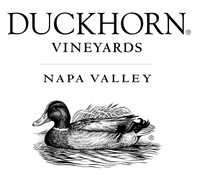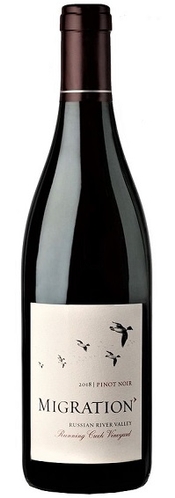Duckhorn Vineyards, founded in 1976 by Dan and Margaret Duckhorn in Napa Valley, outside the town of St. Helena, has become one of the largest and most complex wine companies in California, now with a portfolio, at last count, of ten different Duckhorn-owned wineries spread throughout California and Washington state:
Duckhorn Vineyards
Paraduxx
Goldeneye (Anderson Valley, Mendocino)
Migration (Anderson Valley, Mendocino, original home)
Decoy
Canvasback (Washington)
Calera (Central Coast)
Kosta Browne (Sonoma)
Greenwing (Washington)
Postmark (Paso Robles, Santa Barbara)

Duckhorn began in 1978 by releasing 800 cases each of Cabernet Sauvignon and Merlot. Until that time, Merlot had been used in California mainly as a supplementary grape variety in blended wines. The Merlot grapes came from the about-to-become-famous Three Palms Vineyard in Calistoga, north of St. Helena (which the Duckhorn company purchased later, in 2015). Duckhorn Vineyards rose to fame with its amazing varietal Merlot in 1978 and 1979. No one had ever tasted a Merlot varietal wine this good from California! It was a personal triumph for Dan Duckhorn, who had championed this variety. His winemaker then was the famed Tom Rinaldi. Their Merlot definitely put the Duckhorn name into California’s wine history. Duckhorn’s Cabernet Sauvignon was very good as well; but there were plenty of good Cabs in California, and no great Merlots.

With this success, Duckhorn grew larger and more famous. The Duckhorns owned the business for 31 years until 2007, and then sold controlling interest in their company to a private equity company in San Francisco. Interestingly, Alex Ryan, who worked for Duckhorn in vineyard management and production since 1988, and became President in 2005, is currently still the President and CEO of Duckhorn. Alex is credited with establishing the Duckhorn Portfolio of wines now being sold in five continents and more than 50 countries around the world.
The Migration brand, launched by Alex Ryan, obtains its grapes from the Sonoma Coast, Anderson Valley in Mendocino, and vineyards in Santa Barbara County. Migration specializes in Pinot Noir and Chardonnay. Most of Duckhorn’s company names have some reIationship to ducks. The Migration wine labels feature ducks migrating, symbolic of Duckhorn-owned wines migrating from its original home in Napa Valley to other regions throughout the West Coast of the U.S.
Pinot Noir, one of the oldest wine grape varieties, dates back at least 2,000 years, when the Romans discovered the natives of Gaul (now France) enjoying wine made from Pinot Noir. France’s Burgundy region is still considered the ancestral home of Pinot Noir. This wine variety is often a challenge for winemakers; Duckhorn’s Pinot Noirs come mainly from recognized Pinot Noir vineyards in California.
The winemaker of Migration since 2014 has been Dana Epperson. I recently tasted five Pinot Noirs from Migration, four of which are from single vineyards. The order of tasting the wines has been suggested by Ms. Epperson:
2018 Migration Sonoma Coast Pinot Noir ($36): Fruity, fairly light-bodied wine with soft tannins and flavors of red cherries. Lovely aromas of ripe cherries. Easy-drinking, ready to drink now. 6,138 cases produced. Alcohol: 14.1%.
90
2018 Migration Pinot Noir, Bien Nacido Vineyards, Santa Maria Valley, Santa Barbara County ($70): Intense, concentrated, with pronounced, but soft, tannins. Well-structured, made to last. Pronounced red and black flavors, more black than red. Some earthy notes. I would hold this Pinot Noir from the famed Bien Nacido vineyard for a few years. Only 117 cases produced. 14.1 % alcohol.
93
2018 Migration Sta. Rita Hills Pinot Noir Drum Canyon Vineyard, Sta. Rita Hills, Santa Barbara County ($70): Complex, fruity, black cherry flavors, concentrated and intense. Somewhat tannic, yet more approachable than the Migration Bien Nacido Pinot Noir at this point. From a cool vineyard site. 211 cases produced. 14.1 % alcohol.
94
2018 Migration Russian River Valley Pinot Noir, Dutton Ranch, Sonoma ($70): Rich, complex, fruity; a beautiful wine, from the acclaimed Dutton Ranch vineyard. 201 cases produced. This is a Pinot Noir that will last for two decades at least, although enjoyable now. 14.5 % alcohol.
95
2018 Migration Russian River Valley Pinot Noir, Running Creek Vineyard, Sonoma ($70): Concentrated, tannic, yet elegant, with flavors of ripe black cherries. Wow! This wine is stunning, as good a Pinot Noir from California that I can recall tasting. It has that combination of power and charm. Only 121 cases produced. 14.5% alcohol. It is delicious right now, but surely will last for decades with its balance and structure. Kudos to the winemaker and the team at Duckhorn.
98
Duckhorn’s wines are an amazing success story. To think that a winery with a portfolio of wines this huge can produce such fine Pinot Noirs is truly impressive. By the way, I also tasted Migration’s Sonoma Coast Chardonnay ($35) and liked it very much. Since I l had only one Chardonnay to taste, I did not include it in this rundown. Duckhorn has taken on the difficult Pinot Noir variety head on and has succeeded. Bravo!